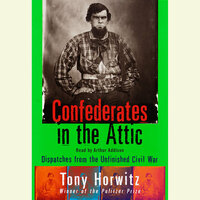Take a photo of a barcode or cover
informative
This is an interesting book about not only the historic battles but of the ways people remember them both large and small. I especially liked Horwitz's encounters with people such as Hodge and the various museum docents across the South.
I've read a few of Tony Horwitz's books. They never fail to amuse and educate. this book made me think of the place I now have called home for more than 15 years. I still do not understand the South but I do understand it better having absorbed the culture over the last several years. This book helped to put things into perspective. It would be interesting to see an update to this book especially the "I Had A Dream" chapter.
Very entertaining and eye-opening look at how the legacy of the South's defeat in the Civil War remains a major part of people's lives today.
Full disclosure: I've spent my entire life in the northeast U.S. so I fall into the Yankee category.
On to my biased review:
What I liked: Everything. Horwitz is a very talented writer. His style is fluid, thoughtful and engaging. I wouldn't say he's funny so much as amusing and I was amused quite often. He has a great eye for interesting details and presents his material very well. (I would say the same about Peter Hessler except that Hessler is very funny.) We meet a wide variety of people in Horwitz's travels through the southeast U.S. and all were worth knowing. I particularly liked chapter 5 (Kentucky: Dying for Dixie) and his treatment of the Michael Westerman murder. Westerman came to epitomize what fit the point of view of very different groups of people, good and bad. I could read that chapter again and again. Horwitz also did a great job delving into people's feelings about race and confronting inconsistencies in their beliefs. Chapter 14 (Alabama: I Had a Dream) was also excellent. (Horwitz's verbal battle with Rose Mary Sanders was excellent and worth revisiting.)
What I didn't love: Some sections were a tad long. Chapter 10 (Virginia and Beyond) could have been effectively shortened. It was never less than good so this is merely a quibble. The final chapter was below the higher standards of the earlier chapters but it was very short.
What I disliked: Nothing.
Parting thought: I held off reading this book because the cover photo was off putting. That was a mistake. I'm too easily influenced by cover art. There's probably a saying that fits this situation.
On to my biased review:
What I liked: Everything. Horwitz is a very talented writer. His style is fluid, thoughtful and engaging. I wouldn't say he's funny so much as amusing and I was amused quite often. He has a great eye for interesting details and presents his material very well. (I would say the same about Peter Hessler except that Hessler is very funny.) We meet a wide variety of people in Horwitz's travels through the southeast U.S. and all were worth knowing. I particularly liked chapter 5 (Kentucky: Dying for Dixie) and his treatment of the Michael Westerman murder. Westerman came to epitomize what fit the point of view of very different groups of people, good and bad. I could read that chapter again and again. Horwitz also did a great job delving into people's feelings about race and confronting inconsistencies in their beliefs. Chapter 14 (Alabama: I Had a Dream) was also excellent. (Horwitz's verbal battle with Rose Mary Sanders was excellent and worth revisiting.)
What I didn't love: Some sections were a tad long. Chapter 10 (Virginia and Beyond) could have been effectively shortened. It was never less than good so this is merely a quibble. The final chapter was below the higher standards of the earlier chapters but it was very short.
What I disliked: Nothing.
Parting thought: I held off reading this book because the cover photo was off putting. That was a mistake. I'm too easily influenced by cover art. There's probably a saying that fits this situation.
Very nicely done -- Horwitz captures the bizarre and repugnant moments and characters as well as he does the poignant and sympathetic ones. This book made me laugh, gasp, and touch my heart.
I adored this book. I truly did.
I bought it when I moved from the Midwest into the heart of the South (Atlanta, Ga), and it was exactly the introduction I needed to my new home state.
I could rave about his excellent research, quality writing, and phenomenal dedication to the task at hand (not to mention throwing out there that he has a Pulitzer for reporting!), but I really want to say this: He's married to my favorite author of all time, Geraldine Brooks, so he's obviously a man worthy of our attention!
I bought it when I moved from the Midwest into the heart of the South (Atlanta, Ga), and it was exactly the introduction I needed to my new home state.
I could rave about his excellent research, quality writing, and phenomenal dedication to the task at hand (not to mention throwing out there that he has a Pulitzer for reporting!), but I really want to say this: He's married to my favorite author of all time, Geraldine Brooks, so he's obviously a man worthy of our attention!
I picked up Confederates in the Attic shortly after events in Charlottesville. Subtitled "Dispatches from the unfinished Civil War," Pulitzer Prize-winning war correspondent Tony Horowitz travels the Southern U.S. to find out how attitudes about the Confederacy are still alive today. Horowitz delves into family pride, race, culture and the dark side of Confederate affiliation. Teachers, historians, bikers, a Scarlett O'Hara impersonator, and the last living Confederate bride all offer their perspective of how and why the ghosts of the Civil War are kept alive. Touring war sites with 'hardcore' re-enactor Robert Lee Hodge is a highlight of the book, which is by turns funny, sad and disturbing. The book is as timely today as it was when first written 20 years ago. Highly recommended; one of the best books I've read thus far this year.
If you want a non-traditional history lesson on the Civil War (with social commentary on our education, social and political systems), this book is for you. While it's focused solely on states of the Confederacy, it spans both sides of the war regarding its characters, sentiments and fact-telling. The characters Tony encounters are a mixed bag of flat-affected and eccentrically enthusiastic; very rarely does he come across a 'next door neighbor' type individual.
I thoroughly enjoyed this exploration of Civil War memory and white identity in the American South, and even though it was published 20 years ago, it felt very relevant given recent events in Charlottesville and the current political divide in the US. I give it four instead of five stars only because the attempt to address ongoing racism and Black attitudes toward the Civil War felt cursory and the author didn’t address or interrogate his own racism (which all of us have) at times when he had an opportunity to do so, particularly in the chapters in Alabama.



